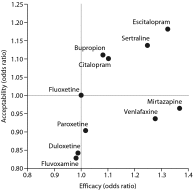A review of antidepressant therapy in primary care: current practices and future directions
- PMID: 23930234
- PMCID: PMC3733527
- DOI: 10.4088/PCC.12r01420
A review of antidepressant therapy in primary care: current practices and future directions
Abstract
Objective: To provide general practitioners with a comparison of major depressive disorder treatments received in primary care and psychiatric clinic settings, a focus on treatment outcomes related to currently prescribed antidepressants, and a review of new and emerging therapeutic strategies.
Data sources: English-language evidence-based guidelines and peer-reviewed literature published between January 1, 2005, and December 31, 2011, were identified using PubMed, MEDLINE, and EMBASE. All searches contained the terms major depressive disorder and unipolar depression, and excluded the terms bipolar disorder/manic depressive disorder. The following search terms were also included: naturalistic study, antidepressant, relapse, recurrence, residual symptoms, response, remission, sequential medication trials, and treatment-resistant depression.
Study selection: Meta-analyses, systematic reviews, and practice guidelines were included. Bibliographies were used to identify additional articles of interest.
Data extraction: Abstracts and articles were screened for relevance to primary care practice. Population-based studies and those involving patients treated in primary care were used whenever possible.
Data synthesis: Achieving remission from a major depressive episode is important to improve functional outcomes and to reduce relapse and recurrence. Despite the availability of numerous antidepressants, as many as 50% of patients require treatment modifications beyond first-line therapy. Among remitters, 90% report residual symptoms that may interfere with function. Patients treated in primary care often have chronic depression (symptom duration ≥ 24 months at presentation) and medical comorbidities. These are clinical predictors of worse outcomes and require individualized attention when treatment is initiated. Antidepressants differ in efficacy, tolerability, and side effects-factors that may affect adherence to treatment.
Conclusions: Major depressive disorder is highly prevalent in primary care and is among the most common causes of loss of disability-adjusted life-years worldwide. There are few differences in clinical profiles between depressed patients in primary care and those in specialist clinics, although differences in symptoms and comorbid conditions among individual depressed patients present a challenge for the physician providing individualized treatment. The goal of treatment is remission with good functional and psychosocial outcomes. Physicians in primary care should have expertise in working with a number of current antidepressant approaches and an awareness of new and emerging treatments.
Figures



Similar articles
-
Beyond the black stump: rapid reviews of health research issues affecting regional, rural and remote Australia.Med J Aust. 2020 Dec;213 Suppl 11:S3-S32.e1. doi: 10.5694/mja2.50881. Med J Aust. 2020. PMID: 33314144
-
Considerations when selecting an antidepressant: a narrative review for primary care providers treating adults with depression.Postgrad Med. 2023 Jun;135(5):449-465. doi: 10.1080/00325481.2023.2189868. Epub 2023 Apr 5. Postgrad Med. 2023. PMID: 36912037 Review.
-
[Antipsychotics in bipolar disorders].Encephale. 2004 Sep-Oct;30(5):417-24. doi: 10.1016/s0013-7006(04)95456-5. Encephale. 2004. PMID: 15627046 Review. French.
-
Review of evidence for use of antidepressants in bipolar depression.Prim Care Companion CNS Disord. 2014 Oct 16;16(5):10.4088/PCC.14r01653. doi: 10.4088/PCC.14r01653. eCollection 2014. Prim Care Companion CNS Disord. 2014. PMID: 25667812 Free PMC article. Review.
-
The future of Cochrane Neonatal.Early Hum Dev. 2020 Nov;150:105191. doi: 10.1016/j.earlhumdev.2020.105191. Epub 2020 Sep 12. Early Hum Dev. 2020. PMID: 33036834
Cited by
-
The role of patient-provider communication: a qualitative study of patient attitudes regarding co-occurring depression and chronic diseases in Malawi.BMC Psychiatry. 2020 May 19;20(1):243. doi: 10.1186/s12888-020-02657-2. BMC Psychiatry. 2020. PMID: 32429877 Free PMC article.
-
Current Problems in the Research and Development of more Effective Antidepressants.Shanghai Arch Psychiatry. 2016 Jun 25;28(3):160-165. doi: 10.11919/j.issn.1002-0829.216017. Shanghai Arch Psychiatry. 2016. PMID: 28638186 Free PMC article.
-
Use of Extracellular Monomeric Ubiquitin as a Therapeutic Option for Major Depressive Disorder.Pharmaceuticals (Basel). 2024 Jun 27;17(7):841. doi: 10.3390/ph17070841. Pharmaceuticals (Basel). 2024. PMID: 39065692 Free PMC article.
-
Latent Profile Analysis of Childhood Maltreatment and Neural Markers in Depression.JAMA Netw Open. 2025 Aug 1;8(8):e2525147. doi: 10.1001/jamanetworkopen.2025.25147. JAMA Netw Open. 2025. PMID: 40758349 Free PMC article.
-
Vortioxetine: first global approval.Drugs. 2014 Jan;74(1):135-45. doi: 10.1007/s40265-013-0161-9. Drugs. 2014. PMID: 24311349
References
-
- Lopez AD, Mathers CD, Ezzati M, et al. Global and regional burden of disease and risk factors, 2001: systematic analysis of population health data. Lancet. 2006;367(9524):1747–1757. - PubMed
-
- Simon GE, Revicki D, Heiligenstein J, et al. Recovery from depression, work productivity, and health care costs among primary care patients. Gen Hosp Psychiatry. 2000;22(3):153–162. - PubMed
LinkOut - more resources
Full Text Sources
Other Literature Sources
